
The Bodzin Art Gallery Presents: Curator’s Conversation with J Artists, with Anne Schlachter-Dagan
There are some conversations that stay with us forever. I was lucky to have one such conversation with Anne Schlachter-Dagan at opening night of the 11th annual ReelAbilities Film Festival: Northern Virginia
Anne Schlacter-Dagan’s oil paintings and digital artworks offer a glimpse into her personal experiences and highlight the difficulties she encounters in perceiving light and color. We spoke about her process as an artist. I was able to ask Anne about her reaction to the four short films, which all focused on artists and entrepreneurs with disabilities, most of them blind. We wrapped up our conversation by talking about how a blind artist can change the world. This blog recounts some of that conversation for you now.
Anne, myself, and our audience were very moved by how powerful it is to share stories that defy what most people hold true. I invite you to come see for yourself how important shifting your perceptions of what a legally blind, color blind artist can do. “Bright Darkness” is on view in the Bodzin until March 6, 2024.
When did you start making art and what keeps you going?
I discovered my passion for art when I was very you and during high school, I pursued it as my major. However, after life led me on a different journey, I only returned to art in 2015 while living in South America. Under the guidance of artist Paul Birchall, I realized my creative potential. The drive to create new, intriguing things and push my limits keeps me going. I must say though that having a supportive partner enables me to balance art, a full-time job, and raising three children.
How did you gravitate to the medium and style you are working in?
I express my artistic vision through oil and digital paintings. Due to limited vision, working with oils suits me as it allows for a slower pace and easy revisiting, unlike acrylics for example. Discovering the digital medium during my B.A. in Studio Arts, 5 years ago, opened up new possibilities, offering the magic of enlarging everything on the screen.
In terms of style, my focus lies in capturing light. I contemplate its impact – whether harsh or soothing – and through a slightly unreal approach, I draw attention to it. Transitioning from realistic to more emotionally driven paintings took time but enriched my artistic journey.
Since you shared that you have difficulty detecting color, how do you select the colors we can see in your art?
Given my inability to detect color, selecting specific colors is impossible. I often opt for random choices, but I’m influenced by societal color meanings. I incorporate monochromatic elements in each painting so for me, each painting looks colorful.
Do you have any advice to share with aspiring artists?
My main advice is TRY! and don’t shy away from making mistakes—they are steppingstones to growth. Happy creating!









